Especially in the last decades the cable transport market has become increasingly colorful. That is why for easier systematization and definition, different lift types have received specific codes.
The code structure:
[person]-[type]/[additional equipment], where the [person] means: capacity, per passenger unit.
Most common types are:
CLF - ChairLift Fix
Main principle: carriers fastened to a fixed point on the rope with non-detachable grips. At the terminals (mountain and valley station) chairs turn back around the bullwheels.
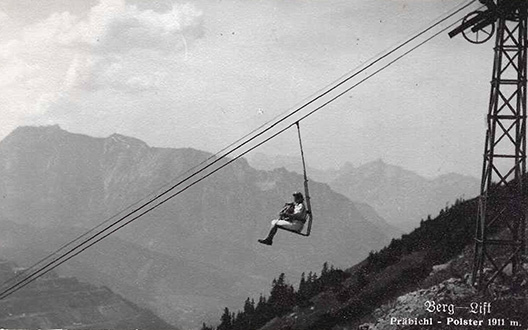
1-CLF (single person) chairlift - one of the oldest passenger cableway types.
(Facebook-group Praebichl.Rettet.Den.Polsterlift)
CLD - ChairLift Detachable
Main principle is: carriers are provisionally fastened on the rope with detachable grips. At the terminals the grip releases, the chair leaves the circulating high speed cable loop. After slowing down, it turns back by a slower and full automatic transporting chain system for the convenient and safety loading and unloading.

The Penken Express at Ziller-valley, Austria. Type code is: 6-CLD.
(www.lift-world.info Radim Polcer)
CLD/B - ChairLift Detachable with Bubbles
Same as CLD-lift (see above), but equipped with plastic bubble against wind and snowfall.
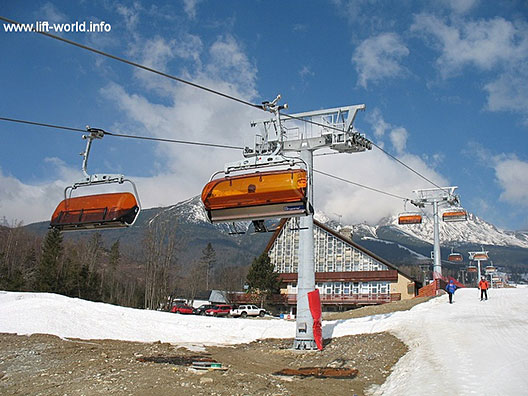
Chairlift type 6-CLD/B with orange bubble at Tatranská Lomnica, Slovakia.
(www.lift-world.info - Radim Polcer)
MGD - Monocable Gondola Detachable
The principle of operation is similar to CLD-lifts: each carrier unit, i.e. gondola, equipped with detachable grip. At the terminals the grip releases, the gondola leaves the circulating high speed cable loop. After slowing down, it turns back (or go forward) by a full automatic transporting chain system for the convenient and safety loading and unloading. The term monocable means that a single cable loop is used to carry and move the gondolas alike. In german speaking areas is often used abbreviation EUB after "Einseilumlaufbahn" , that means: circulation cable car with single rope.
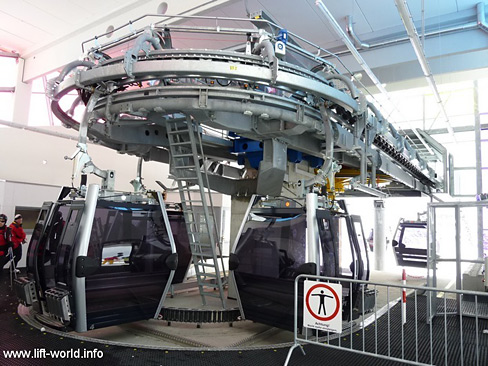
Terminal of a type 8-MGD lift.
(www.lift-world.info - Radim Polcer)
BGD - Bicable Gondola Detachable
The principle of operation is similar to the MGD-lifts (see above), but this type of construction uses two ropes: one circulating haulage loop for tractioning and one stationary that supports the cabins (or gondolas). Besides detachable grip, cabins equipped with roller gear for running along the support cable. In german speaking areas is often used abbreviation ZUB after "Zeiseilumlaufbahn", that means: circulation cable car with two ropes.
Benefits of BGD:
- Large spans can be bridged e.g. between two supporting tower.
- Fleet of relative large capacity cabins can be moved by a small constructed drive system, because the task of the moving and supporting is divided between two rope systems.
Thanks to its favorable transport capacity, it has been used in several places since the 1950s.
Zwölferhorn Seilbahn, a type 4-BGD hystorical lift, near to Wolfgangsee, in Austria. It was installed in 1957. (own image)
CGD - Chairlift / Gondola Detachable
ChairLift Detachable (CLD) and Monocable Gondola Detachable (MGD) combinated in one cable loop:
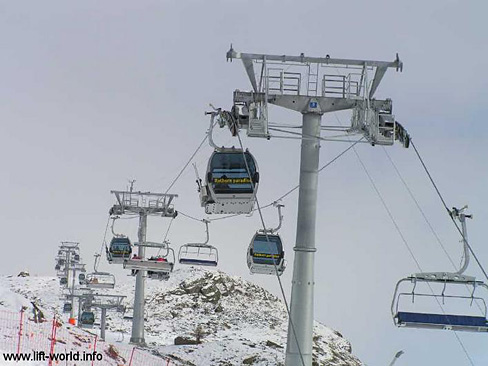
Type 6/8-CGD lift at ski area Zermatt with 6-passenger seats and 8-passenger gondolas.
(lift-world.info - Theo)
FUT - Funitel
Funitel (is a portmanteau between French words funiculaire and telepherique) attends the principle of operation of MGD, however a pair of cable loops hauling the large capacity cabins, providing greater lateral stability allowing the system to operate in higher cross-winds.
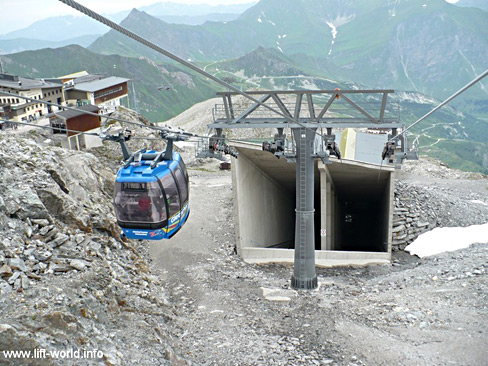
24-FUT in Hintertux, Austria. (www.lift-world.info - Radim Polcer)
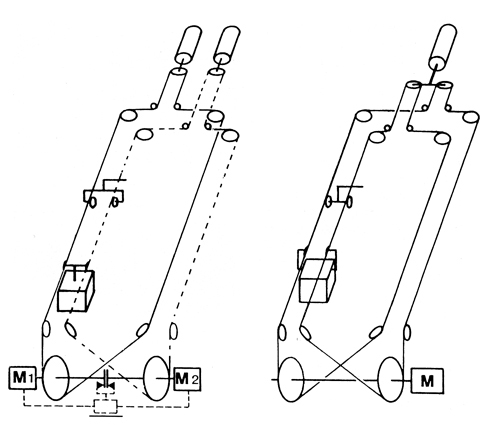
There are two subtypes of Funitel systems: DLC (left side) and DMC (right side). DLC consists Double Loop Monocable with two parallel engines, DMC means Double MonoCable with one loop and drive. Disadvantage of DMC: system requires extra long rope loop (logistic problem); the rope is more exposed to mechanical stresses, resulting shorter lifetime (more costly operation). (www.alpinforum.com)
TGD - Tricable Gondola Detachable
In german speaking areas the popular abbreviation is "3S" after the term "DreiSeilumlaufbahn". The principle of operation is similar to the BGD-lifts, however this type of construction uses one circulating haulage cable loop for tractioning and two stationary cables that support the cabins (or gondolas). Besides detachable grip, gondolas equipped with a pair of roller gears for running along the support cables. The system has similar advantages as the BGD type, therefore ideal for bridging two mountain peaks or a wide river, etc.
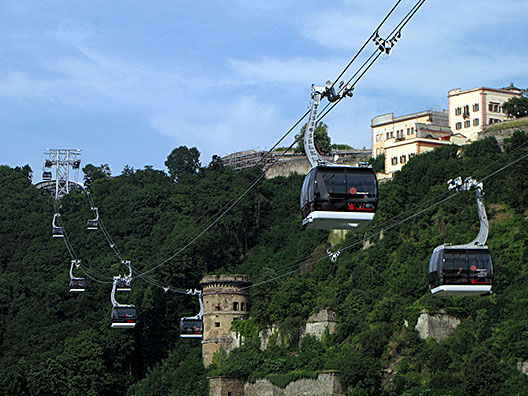
Type 35-TGD over river Rhine, in Germany. (Wikimedia - Holger Weinandt)
AT (or ATW) - Aerial Tramway
Non-circulation cable car, i.e. reversible system: one or two carrier units shuttling back and forth between two terminals propelled by a cable loop which stops and reverses direction when the cabins arrive at the end stations. The most known instance of AT's is the large-cab version, which has relatively big capacity per transport unit: from 30 to 160 or more. It was used in many places before the Second World War, mainly for approaching high-altitude tourist attractions, the most successful producer from that period was Bleichert company in Germany. In german speaking areas is often used abbreviation PB after term "Pendelbahn" (as Pendulum cablecar) referring to its back-and-forth-shuttling movement.
The world's oldest operating cable car which has been preserved in its original condition is the Predigtstuhlbahn in Germany. Its type code 25-AT and the manufacturer was the Bleichert company. (own image)
MGFP - Monocable Gondola Fixed Pulsed
The base structure: one or more pairs of cabin groups, involved 3-5 pieces of carrier per group which are fastened on a circulated cable loop. As the cabins which are equipped with fix grip systems arrive to the end station, the whole cable system stops. After loading and unloading, lift is restarted first with carefuly speed, because the group of cabins turns back around the bullwheel before continues the trip back. The last letter 'P' of the code string 'MGFP' also refers that kind of operation.

Karwendelbahn (Pertisau) in Austria, type 16-MGFP. The type code is slightly inaccurate, as it does not reveal how many 16-person cabins are involved in a group. (own image)
BGFJ - Bicable Gondola Fixed Jigback
The structure is similar to the type 'MGFP' group-lift (see above), however as the group of cabins arrives to the end station and stops, the driving-gear reverses the direction, that is carriers not turns back around the bullwheel. This construction uses traction cable for hauling, and stationary cable for supporting, if necessary. Its operation is similar to the Aerial Tramway (type AT).
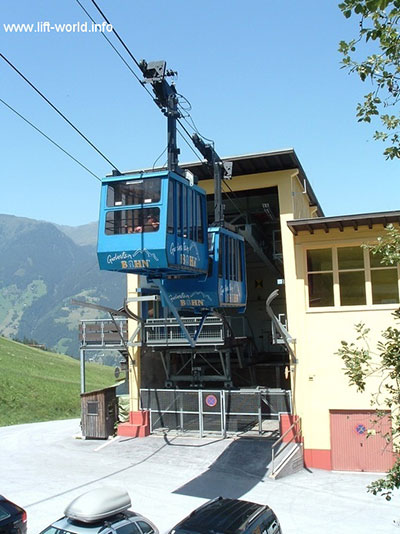
Gerlossteinbahn type 27-BGFJ near to Zell am Ziller in Austria.
(www.lift-world.info - Radim Polcer)
FUF - Funifor
The Funifor system can be considered as an upgraded version of the classic Aerial Tramway (AT) system. This also works with two separate rope systems: a circulating haulage loop for tractioning and a stationary that supports the cabins - which equipped with roller gears for running along support cables. In Funifor systems these two types of rope duplicated, which run along the longitudinal edges of the cabine, providing greater lateral stability allowing the system to operate in higher cross-winds:
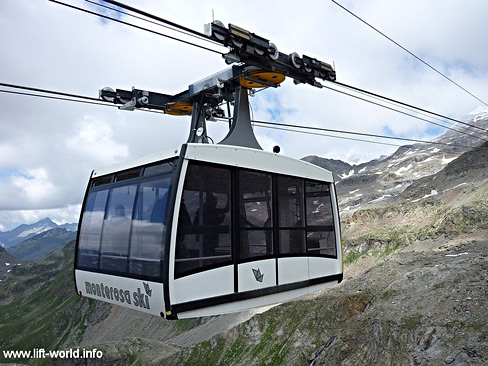
Funifor type 60-FUF at Gressoney, in autonomous region Aosta Valley, Italy.
(www.lift-world.info - Radim Polcer)
SL - Surface Lift
Skiers and snowboarders by means of these classical lifts are pulled uphill, in which passengers remain on the ground throughout the whole journey. The most common representative of surface lifts is the so called J-bar (single person) and T-bar (double person) lift. Benefits of Surface Lift are the simple construction and low maintenance cost. Disadvantages: its low speed, uncomfortable over longer distance. Today, surface lifts are most often found on beginner slopes and very small ski areas.
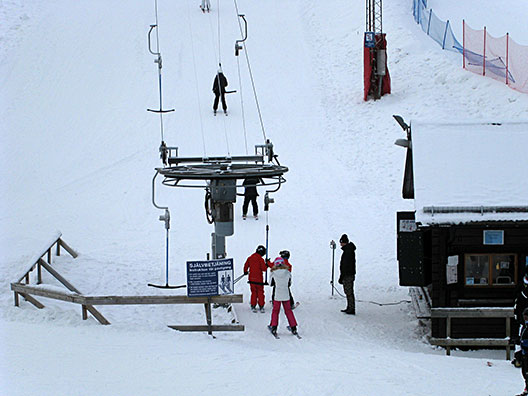
Type 2-SL, i.e. T-bar lift in Sweden. (Wikimédia - Bysmon)
FUC - Funicular
Funicular also known as inclined plane or cliff railway in which a cable attached to a pair of tram-like vehicles on rails moves them up and down a steep slope, the ascending and descending vehicles counterbalancing each other. Vehicles can run on a separate or shared rails in the middle with a siding section.
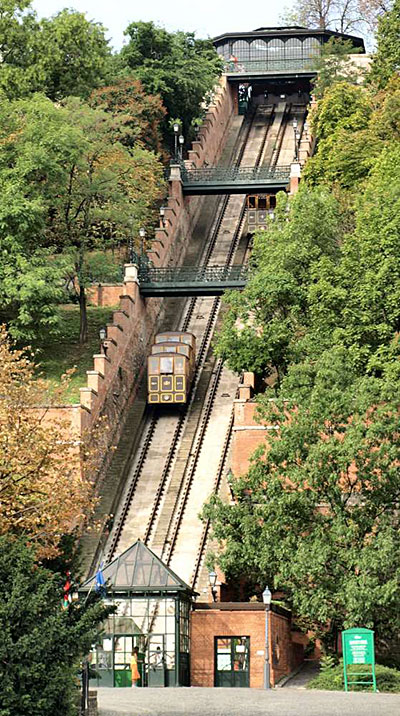
Budapest Castle Hill Funicular - type 24-FUC in Hungary
(Wikimédia - Misibacsi)
Special types:
BL - Bucket Lift or Basket Lift
These lifts are, by their name is, reminiscent of open basket, wherein two persons can travel standing on the floor. The lift operator locks the lattice door after boarding not to fall out during the trip. Due to its less widespread use, it does matter rather technical rarity and curiosity. Benefits are its cheap construction and operation. Its disadvantage: baskets are mounted on the ropeway with non-detachable grips, that is why the speed of the whole cable system have to be reduced by loading and unloading, or passengers have to jump up quickly. In this case, it also depends on operator's attention and skill for avoiding accidents.
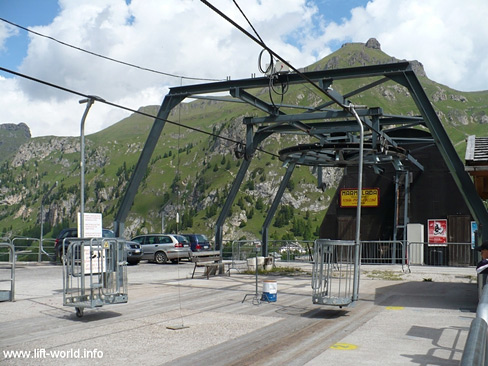
2-BL at Val di Fassa, Italy.
(www.lift-world.info - Radim Polcer)
MGF - Monocable Gondola Fixed
The principle of operation is similar to CLF-lifts: each carrier unit, i.e. gondola, equipped with non-detachable grip, at the terminals (mountain and valley station) cabins turn back around the bullwheels. Benefits are its cheap construction and operation. Its disadvantage the extremely low speed for safe and comfortable boarding. There is a very interesting instance of MGF where the used cabin fleet was bought from a traditional MGD system (see below):
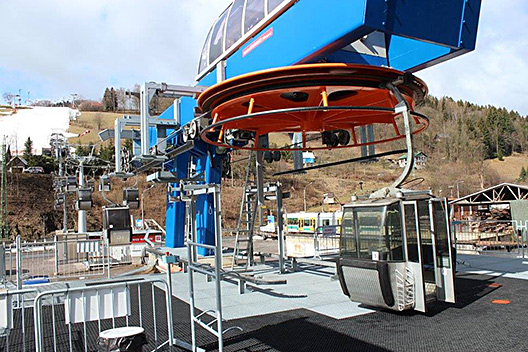
Type 4-MGF from ski area Herlíkovice - Bubákov, in Czech Republic.
(Facebook site of www.lanove-drahy.cz)
RPC - Ropeway Conveyor or Material Ropeway
Cargo ropeway. There are plenty of known types, such as material ropeway of mines, alpine huts or building operations in high mountains (e.g. reservoirs), etc.
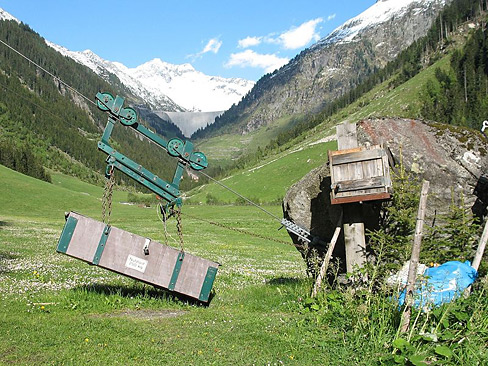
The simplest version of type RPC: a material ropeway serving alpine huts.
(Wikimédia - Christoph Praxmarer)
Translated from original entry 06-11-2016




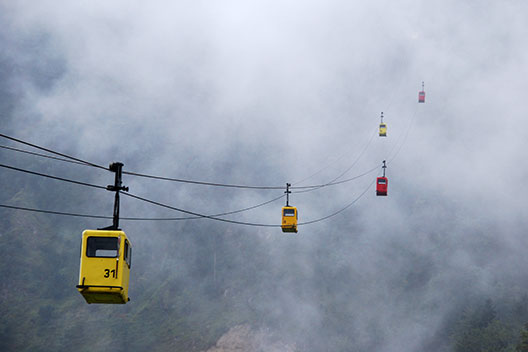
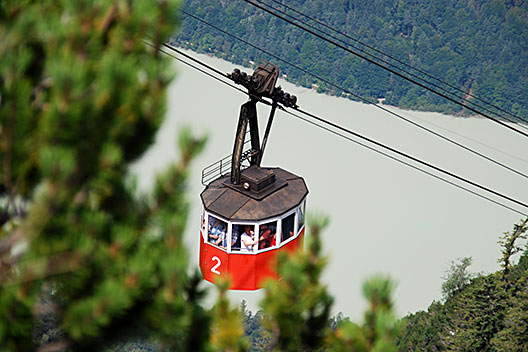
Címkék: type guide
Ajánlott bejegyzések:
Kommentek:
A hozzászólások a vonatkozó jogszabályok értelmében felhasználói tartalomnak minősülnek, értük a szolgáltatás technikai üzemeltetője semmilyen felelősséget nem vállal, azokat nem ellenőrzi. Kifogás esetén forduljon a blog szerkesztőjéhez. Részletek a Felhasználási feltételekben és az adatvédelmi tájékoztatóban.